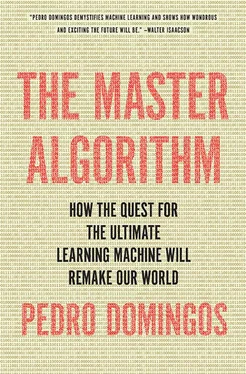A common complaint about big data is that the more data you have, the easier it is to find spurious patterns in it. This may be true if the data is just a huge set of disconnected entities, but if they’re interrelated, the picture changes. For example, critics of using data mining to catch terrorists argue that, ethical issues aside, it will never work because there are too many innocents and too few terrorists and so mining for suspicious patterns will either cause too many false alarms or never catch anyone. Is someone videotaping the New York City Hall a tourist or a terrorist scoping out a bombing site? And is someone buying large quantities of ammonium nitrate a farmer or a bomb maker? Each of these looks innocent enough in isolation, but if the “tourist” and the “farmer” have been in close phone contact, and the latter just drove his heavily laden pickup into Manhattan, maybe it’s time for someone to take a closer look. The NSA likes to mine records of who called whom not just because it’s arguably legal, but because they’re often more informative to the prediction algorithms than the content of the calls, which it would take a human to understand.
Social networks aside, the killer app of relational learning is understanding how living cells work. A cell is a complex metabolic network with genes coding for proteins that regulate other genes, long interlocking chains of chemical reactions, and products migrating from one organelle to another. Independent entities, doing their work in isolation, are nowhere to be seen. A cancer drug must disrupt cancer cells’ workings without interfering with normal ones’. If we have an accurate relational model of both, we can try many different drugs in silico , letting the model infer their good and bad effects and keeping only the best ones to try in vitro and finally in vivo .
Like human memory, relational learning weaves a rich web of associations. It connects percepts, which a robot like Robby can acquire by clustering and dimensionality reduction, with skills, which he can learn by reinforcement and chunking, and with the higher-level knowledge that comes from reading, going to school, and interacting with humans. Relational learning is the last piece of the puzzle, the final ingredient we need for our alchemy. And now it’s time to repair to the lab and transmute all these elements into the Master Algorithm.
CHAPTER NINE: The Pieces of the Puzzle Fall into Place
Machine learning is both a science and a technology, and both characteristics give us hints on how to unify it. On the science side, unifying theories often begin with a deceptively simple observation. Two seemingly unrelated phenomena turn out to be just two faces of the same coin, and like the first domino to fall, that realization sets off a cascade of others. An apple falling to the ground, the moon hanging in the sky: both are caused by gravity, and-apocryphal story or not-once Newton figured out how, gravity turned out to also account for the tides, the precession of the equinoxes, the trajectories of comets, and much else. In everyday experience, electricity and magnetism are never seen together: a lightning spark here, a rock that attracts iron objects there, both quite rare. But once Maxwell figured out how a changing electric field gives rise to magnetism and vice versa, it became clear that light itself is an intimate marriage of the two, and today we know that, far from rare, electromagnetism pervades all matter. Mendeleev’s periodic table not only organized all the known elements into just two dimensions, it also predicted where new elements would be found. Darwin’s observations aboard the Beagle suddenly began to make sense when Malthus’s Essay on Population suggested natural selection as the organizing principle. When Crick and Watson hit on the double helix structure as an explanation for the puzzling properties of DNA, they immediately saw how it might replicate itself, and biology’s transition from stamp collecting (in Rutherford’s pejorative words) to unified science had begun. In each of these cases, a bewildering variety of observations turned out to have a common cause, and once scientists identified it, they could in turn use it to predict many new phenomena. Similarly, even though the learners we’ve met in this book seem quite disparate-some based on the brain, some on evolution, some on abstract mathematical principles-they in fact have much in common, and the resulting theory of learning yields many new insights.
Although it is less well known, many of the most important technologies in the world are the result of inventing a unifier, a single mechanism that does what previously required many. The Internet, as the name implies, is a network that interconnects networks. Without it, every type of network would need a different protocol to talk to every other, much like we need a different dictionary for every pair of languages in the world. The Internet’s protocols are an Esperanto that gives each computer the illusion of talking directly to any other and that allows e-mail and the web to ignore the details of the physical infrastructure they flow over. Relational databases do something similar for enterprise applications, allowing developers and users to think in terms of the abstract relational model and ignore the different ways computers go about answering queries. A microprocessor is an assembly of digital electronic components that can mimic any other assembly. Virtual machines allow the same computer to pose as a hundred different computers to a hundred different people at the same time, and help make the cloud possible. Graphical user interfaces let us edit documents, spreadsheets, slide decks, and much else using a common language of windows, menus, and mouse clicks. The computer itself is a unifier: a single device capable of solving any logical or mathematical problem, provided we know how to program it. Even plain old electricity is a kind of unifier: you can generate it from many different sources-coal, gas, nuclear, hydro, wind, solar-and consume it in an infinite variety of ways. A power station doesn’t know or care how the electricity it produces will be consumed, and your porch light, dishwasher, or brand-new Tesla are oblivious to where their electricity supply comes from. Electricity is the Esperanto of energy. The Master Algorithm is the unifier of machine learning: it lets any application use any learner, by abstracting the learners into a common form that is all the applications need to know.
Our first step toward the Master Algorithm will be surprisingly simple. As it turns out, it’s not hard to combine many different learners into one, using what is known as metalearning. Netflix, Watson, Kinect, and countless others use it, and it’s one of the most powerful arrows in the machine learner’s quiver. It’s also a stepping-stone to the deeper unification that will follow.
Out of many models, one
Here’s a challenge: you have fifteen minutes to combine decision trees, multilayer perceptrons, classifier systems, Naïve Bayes, and SVMs into a single algorithm possessing the best properties of each. Quick-what can you do? Clearly, it can’t involve the details of the individual algorithms; there’s no time for that. But how about the following? Think of each learner as an expert on a committee. Each looks carefully at the instance to be classified-what is the diagnosis for this patient?-and confidently makes its prediction. You’re not an expert yourself, but you’re the chair of the committee, and your job is to combine their recommendations into a final decision. What you have on your hands is in fact a new classification problem, where instead of the patient’s symptoms, the input is the experts’ opinions. But you can apply machine learning to this problem in the same way the experts applied it to the original one. We call this metalearning because it’s learning about the learners. The metalearner can itself be any learner, from a decision tree to a simple weighted vote. To learn the weights, or the decision tree, we replace the attributes of each original example by the learners’ predictions. Learners that often predict the correct class will get high weights, and inaccurate ones will tend to be ignored. With a decision tree, the choice of whether to use a learner can be contingent on other learners’ predictions. Either way, to obtain a learner’s prediction for a given training example, we must first apply it to the original training set excluding that example and use the resulting classifier-otherwise the committee risks being dominated by learners that overfit, since they can predict the correct class just by remembering it. The Netflix Prize winner used metalearning to combine hundreds of different learners. Watson uses it to choose its final answer from the available candidates. Nate Silver combines polls in a similar way to predict election results.
Читать дальше












